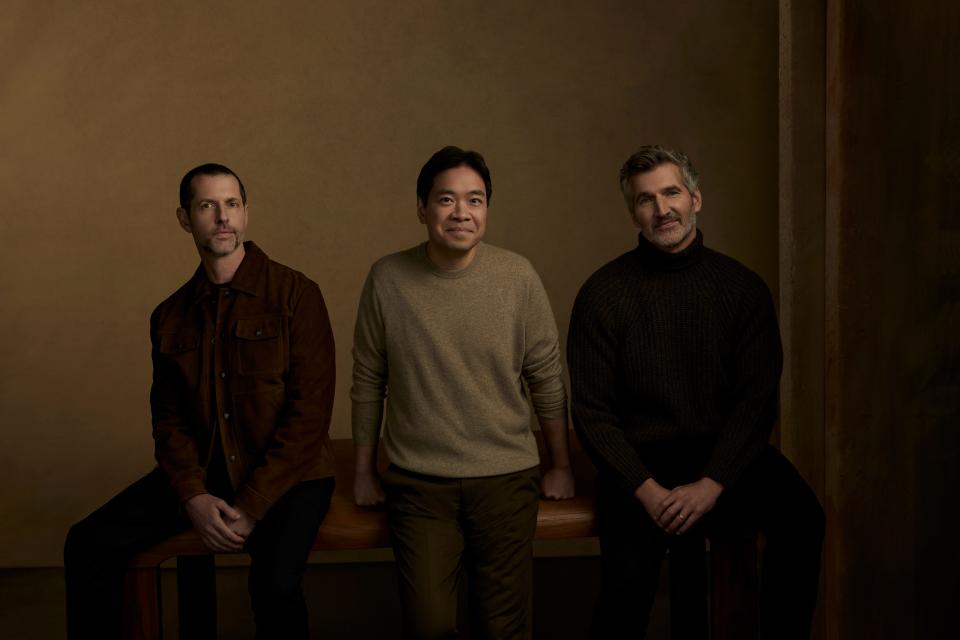What is '3 Body Problem'? Explaining Netflix's trippy new sci-fi and the three-body problem
In Netflix's new series "3 Body Problem," science is broken.
Or so the group of physicists think when things in the world start to go ... haywire. Turns out, in this trippy, visually-stunning mindbender from the creators of "Game of Thrones," things may not be as they seem.
The series, which serves as "the next big thing" from "Thrones" veterans D.B. Weiss and David Benioff, kicked off a bit of a commotion when it debuted Thursday on the streaming platform. You may have noticed that Netflix was a little extra with its promotion of the series on its homepage when you opened the service on Thursday.
If you weren't prepared for it, the hype may have caused some confusion. Or maybe you watched that series premiere and it's just the show itself that has you confused.
Regardless, we're hoping to answer some of your burning questions about the eight-part sci-fi epic streaming now.
Review: '3 Body Problem' is way more than 'Game of Thrones' with aliens
'House of the Dragon' Season 2: HBO releases 'dueling' trailers; premiere date announced

What is the '3 Body Problem' on Netflix?
Based on science fiction series "Remembrances of Earth's Past" by Chinese author Liu Cixin, "3 Body Problem" tells the story of a humanity confronting a terrifying cosmic threat kicked off by a fateful experiment in 1960s China.
Four years in the making, the series is the first big post-"Thrones" project from Weiss and Benioff, who inked a massive deal with Netflix and teamed up with "True Blood" and "The Terror" writer Alexander Woo to executive produce it. The series is named for the first novel in the trilogy by Cixin, who served as a consultant along with Ken Liu, who wrote the English translation of the books.
"We had in mind that we wanted to do a science fiction show, but we weren't sure which one," Benioff said in a roundtable discussion with Weiss and Woo in an inside look at episode 1 on Netflix. Cixin "created these books that are terrifying for anyone foolish enough to try to adapt them and also just made us very hungry to the possibilities."
In a review, USA TODAY critic Kelly Lawler wrote the first season "stands on its own as a huge achievement" and gave it three out of four stars.
The story begins in 1966 during Mao Zedong's Cultural Revolution in China, where Ye Wenjie (Zine Tseng) witnesses the execution of her scientist father before she is forced into labor and imprisonment. As the series debut progresses, Wenjie escapes imprisonment when the Revolution sees a use for her scientific know-how in a little search they're conducting for extraterrestrial life at a mysterious station.
Flash forward to present day, and the group of brilliant scientists and former classmates known as the Oxford 5 are confronted with the consequences of that experiment – primarily, the murder and apparent suicides of scientists around the world. The group isn't part of that original series, but are introduced by showrunners as a means to keep the story grounded amid otherwise weighty philosophical concepts.
"Rather than dryly presenting the nuts and bolts of the physics, we show what it's doing to the people who were confronted by it," Woo said in the Netflix roundtable.

Review: '3 Body Problem' is way more than 'Game of Thrones' with aliens
What is the three-body problem in physics?
As for the name of the show itself, it comes from the term for when three celestial objects (planets, stars, or suns that are in close proximity to each other) exert force onto each other, making the objects’ rotation chaotic and unpredictable, according to Netflix.
“As soon as you have three bodies or more that are all exerting a force on each other at the same time, then that system breaks down,” University of Cambridge associate physics professor Matt Kenzie told Netflix. “If you have three bodies or more, then the orbit becomes chaotic.”
It's a problem with no known general solution.
In the series, Netflix notes, the three-body problem comes into play via the three-sun solar system that San-Ti's planet inhabits, which contributes to stable and chaotic eras.
"When the planet revolves around one sun, it’s a stable era. When another sun snatches the planet away, it wanders in the gravitational field between the three suns, causing a chaotic era. In a chaotic era, the living conditions can become too extreme for life to exist," Netflix writes.
Other concepts in '3 Body Problem'
The show introduces plenty of seemingly outlandish concepts in just its first episode that span the metaphysical and even extraterrestrial.
Early on, it's made clear that amid the mysterious deaths of scientists, experiments in particle accelerators have been producing what should be impossible results. Hence, why viewers are reminded several times by investigator Da Shi (Benedict Wong): "Science is broken."
But it's not that simple, as the Oxford 5 start to learn. When one of them, Auggie Salazar (Eiza González) starts seeing a menacing countdown in her vision, it doesn't take long until she's confronted with a startlingly reality: The numbers aren't a neurological disorder or hallucination, but are very, very real.
And she better hope, for her sake, that they don't reach zero.
"3 Body Problem" also introduced in its first episode a metallic headset resembling a futuristic VR set that will become integral as the series progresses. When physicist Jin Cheng (Jess Wong) dons the contraption, the last thing she sees are her own eyes looking back at her before the scene opens onto a virtual environment that looks straight out of a VR game.
But as everything with this show, there's something vaguely threatening about what is unfolding within that virtual world.
As Woo said, all of this is "emblematic of the inexplicable problems that are confronting the scientists."
"They are not people to believe in the supernatural so whatever is happening ... is scary," Woo said in the roundtable.
When the first episode comes to a close, some of the characters stare up at the sky as stars begin to blink in what may be Morse Code. The development "ups the ante" and makes it clear particularly to Auggie that her countdown isn't just in her mind.
"But its arguably a lot worse if there's something else that's being witnessed by everyone else on the globe," Weiss said.
Interviews: With Netflix series '3 Body Problem,' 'Game Of Thrones' creators try their hand at sci-fi
Cast of '3 Body Problem'

"Game of Thrones" fans will recognize a couple of familiar faces in "3 Body Problem": Liam Cunningham, who portrayed everyone's favorite former smuggler and loyal "onion knight" Davos Seaworth; and John Bradley, best known as the tenderhearted and seemingly meek Samwell Tarly.
Benioff and Weiss even brought over "Thrones" composer Ramin Djawadi for the series' score.
Here's the rest of the cast:
Jess Hong as Jin Cheng
John Bradley as Jack Rooney
Zine Tseng as young Ye Wenjie
Rosalind Chao as older Ye Wenjie
Eiza González as Auggie Salazar
Jovan Adepo as Saul Durand
Alex Sharp as Will Downing
Benedict Wong as Da Shi
Liam Cunningham as Thomas Wade
Marlo Kelly as Tatiana
Eric Lagatta covers breaking and trending news for USA TODAY. Reach him at [email protected]
This article originally appeared on USA TODAY: What is the three-body problem? Netflix's '3 Body Problem' explores
